#covert michigan
Explore tagged Tumblr posts
Text
Growing into the Job, Post 430: Out from the Crowd
“Can you believe all these people?” marveled Kori Kleinman in a covert aside to her co-worker as they stood, in most part head-and-shoulders above the gathering crowd of press, eager future patients, and random Melissa ‘fans’; the parking lot was just teeming with them. The two had been out here, on this atypically bright November day, preparing them all for the press event.
“Yeah huh,” Lexi replied, a smug look on her face. Alexa Samuels had her MBA in marketing, but her classes at Michigan had certainly not taught her to deal with anything like this. Still, she was a smart and competently charismatic girl who, maybe as a result of the few treatments of Program she’d had in her days at Evolution and now the more subtle enhancements she’d enjoyed since being assigned here at Far Horizons, was doing a good job of handling the situation. At least, she thought she was. The ribbon-cutting for the upgraded facility was slated for 13:45 , about an hour from now. Many local TV stations were on the scene, though Channel 5 would have the exclusives.
“Katie should really be out here helping us,” Kori complained through her perfectly practiced smile, showing off her pearly whites as she fielded yet another round of inane questions, this time from a group of goggle-eyed, pimply twerps that looked like they should be in school. Questions about Melissa, of course. Still, she continued to try to beam through her forced smile. “And where the heckin’ heck is Bianca?”
“Yeah, Katie’s doing that job interview, with their old boss,” Lexi answered, handing her card to a sticky-looking guy from Channel 5 who’d wanted to talk about their camera access at the opening gala in the atrium tonight, “and Bianca’s…I dunno where Bianca is.” Though a witch could come in really handy right about now. I'm sure they would have more than a few ways to quiet these people down.
Kori just nodded behind subtly clenched teeth as she continued ushering people as best she could away from the front doors and the velvet-roped sections they’d set up. There were a few of the guys from the basement - Melissa’s ‘monkeys’ - that were arranging chairs behind the makeshift podium and trying their best to remain unseen. Cameras were already being assembled in place. Kori knew someone from the mayor’s office would be arriving soon, probably with their own team of people. As part of the Communications team, she knew it’d be partly her job to make sure everyone knew the deal. Lexi, though, was the one really running the show.
Lexi Samuels, aka Agent 0FHMA011, had been placed in her position in large part to lay the groundwork for this event and to usher in what would soon follow: the aggressive marketing and expansion of Far Horizons Evolution Center into a nationwide brand of medical facilities that would prepare and serve the women of the upcoming new world order in the US. This, today, was ostensibly just a local press event, a silly ribbon-cutting to a new doctor’s office, but Lexi knew the plan was to have this ‘little event’ picked up nationally through the Movement’s burgeoning media empire. Their influence spanned an increasingly extensive web that already boggled Lexi’s mind, and the Movement’s power was only continuing to grow. Similar medical facilities had been successful in other countries where the Movement was more advanced, and had started carrying out their purpose. There was no reason that, with KOLECTV’s help, Far Horizon Evolution Centers couldn’t spring up in every major city from coast-to-coast in the next 12-18 months and from there help spread the Movement's agenda. That was the goal at least, and Lexi knew that her job security partially rested on how well things went today and tonight. She had the support and guidance, of course, from higher-ups at Evolution, as well as Nexifem and KOLECTV, but boots-on-the-ground moments like these were really in her lap.
Kori, a naive and semi-recent Communications grad from Syracuse, had actually been a big help. She seemed pretty committed to the cause and, without the benefit of the partial immunity to Melissa’s pheromones that Lexi’s exposure to Program had given her, Kori was also a dedicated Hive member and Melissa fan. That, for now at least, was fine. Also, her tits had recently gotten huge.
Those pimply twerps from before were ogling them as we speak.
“Scram you little creeps.” With a sheath of papers that held today's itinerary and logistics, Lexi shooed them away. After they scurried, a young blonde girl was left, and stood facing them seemingly undeterred.
“Hello there,” Lexi greeted her, smiling her big smile. The young girl had caught her attention.Tanned, busty in a low-cut blue tee. Short-sleeved in the nice weather. She was fresh-faced as all get-out.
“Hi, Ms. Samuels?” the girl asked.
“Yes?” Lexi answered. If the girl knew her name, she’d done her research.
“My name’s Tia,” she replied, “and I was wondering how I might go about applying for a lifeguard position.”
Lexi nodded silently. There was something about this one that got her antennae up. Not in a bad way, necessarily, just up. Now, she knew they were still looking for lifeguards for the underground clinic pool. Would they hire teenagers? “I'm afraid that’s really not my department, but…”
She looked at the girl. Young, really young. Something shimmered inside her, though. Lexi motioned her closer, speaking softly. “You’re on treatment, aren’t you?”
The girl froze, hesitating a bit. But after a quick sideways glance she replied. “No, but my teacher is. She’s in an experimental, like, study. She comes here for treatment, and it’s been working. On all of us,” she said, “so all us girls in her class have been…”
Her voice trailed off. Lexi knew what she meant to say. As natural a beauty as this girl appeared, her height, figure and composure were remarkable.
“And the boys have been-?“ Lexi prompted, glancing and nodding at the pimply twerps that were now huddled over their phones several yards away. Her classmates, apparently. Here on a class trip? Suddenly they reminded her of small, shrunken little rodents.
“Yeah…they are.” Tia bit her lower lip as she glanced over at the little twerps, “…getting smaller.”
Lexi studied the girl’s reaction, putting it together: a high school teacher, a patient in the Product study clinic here probably, was building a hive of her students. The higher-ups, and the study-coordinator Gianna, were pretty picky-and-choosy about who they brought into the trial. This teacher must have some some sort of connection. Now it was Lexi’s turn to hesitate. She liked the girl well enough, but didn’t know what would transpire if a budding bee from another hive came to work here. What might happen if she was also exposed to Melissa’s pheromones, even if just for a few hours a week?
Could be cool.
“Tell you what,” Lexi said, “I’m going to take your pic, so I remember how adorable you are: smile…”
Tia smiled for Lexi.

“Here’s my card. Send me your stuff, if you have a resume or whatever. I’ll see what I can do about that lifeguard job…”
Lexi regarded her again, thought for a moment.
“Y’know what?” she asked, “We’re having a little gala event here tonight, celebrating the new opening.”
“Yeah I heard,” Tia answered.
This girl has done her homework, Lexi thought again. “How about you drop in, I can introduce you to a few people.”
“For real?” Tia squealed, suddenly belying her youth, eyes wide with enthusiasm.
“Yeah, for real,” Lexi smiled, seeing how the promise of such a fancy, ‘adult’ event was so exciting to the teen, “I’ll get you on the list. Seven o’clock here, tonight. Let me know if you need a dress…”
====================================
thx to ItsThePitts for providing inspiration for the Tia character. We'll see how she...develops. And, of course, RiF for edits.
19 notes
·
View notes
Text
Info and Resources for Questioning Systems
Our old post with resources is out of date and doesn’t have that much information, so we’ve decided to put this together! Please let us know if we should make any corrections or if you have resource ideas you’d like us to add to this post.
NOTE: Before we get started, it’s so important to mention that every system should rule out trauma first before considering other origins. This is because complex dissociative disorders can present in covert ways, and function by hiding trauma from some alters. Even if you’re certain you’re not traumatized, please research and understand complex dissociative disorders before learning about other origin types. It’s possible to not remember or misunderstand trauma. Ruling it out first will save you a lot of difficulty and heartache in the future!
NOTE 2: As a system, we understand the terms “tulpa” and “tulpamancy” are cultural appropriation, and believe that as a community a different term for these systems should be selected. However, until that happens, we will continue to link handy resources for these sorts of systems.
Now, onto the resources!
This is not a complete list! If there’s any resource you’ve found useful and would like us to add, please get in touch!
Websites:
CDD (DID and OSDD-1) Specific:
Beauty after Bruises, and especially their article on myths and misconceptions about DID
Multiplied by One, a DID nonprofit that has a wealth of resources on dissociative disorders and CPTSD (and offering support for those in need!)
First Person Plural, another great nonprofit
ISSTD’s public resources
The Cleveland Clinic’s page on DID
Survivors’ Network (not to be confused with the Survivors’ Network Discord) page on DID
The National Alliance on Mental Illness’ info on dissociative disorders
DIS-SOS, a blog with tons of info on trauma, dissociation, and living with both
osdd.one, a site with information on complex dissociative disorders with a focus on OSDD-1
NAMI Michigan’s DID fact sheet
The Healthy Place’s blog on Dissociative Living
Non-CDD Specific:
What is Plurality/Multiplicity? by YoppVoice
More than One
Tulpa.io, Tulpanomicon, and Tulpa.info, all sites where tulpas, thoughtforms, willomates, and their creators can share their experiences
The Daemon Page
Daemonism 101
Manchester Metropolitan University’s Understanding Multiplicity
Plurality-Resources (traumagenic, not CDD, specific)
The Plurality Playbook, a resource for plurality in the workplace (for employees and managers)
Endogenic Hub
The Dissociative Initiative includes resources for both CDD systems and others who experience multiplicity
Soulbonding Info Carrd
Pluralpedia, a plurality wiki created and maintained by systems for systems
Podcasts:
The System Speak Podcast
The Bag System Podcast
Tumblr Blogs:
If you know of an active, plural-focused tumblr blog that isn’t listed here, feel free to let us know so we can add them!
@pluraldeepdive
@plural-culture-is
@subsystems
@rin-and-jade
YouTubers:
The Alexandrite System
FragmentDID
The Rings System
The CTAD Clinic
(psst! if you’re an endogenic/not-trauma formed system YouTuber, please let us know! we’d love to check out your videos and add your channel to this list!)
Other:
This Google Drive folder has 13 books on mental health, with a focus on dissociative disorders and trauma.
This Google Drive folder also has a bunch of great resources (keep in mind there are some repeats in both drives)
UTEP’s Mental Health Awareness Training infographic on dissociative disorders
Our own posts through our Directory
Seeking help through therapy:
(specifically specialists in dissociative disorders)
Psychology Today’s search page for finding therapists who specialize in dissociative disorders
Carolyn Spring’s article, How to find a therapist for a dissociative disorder
The ISSTD’s Find a Therapist page
Websites we do NOT recommend can be found here! Note: some of the resources we’ve linked here have their own links to websites we don’t recommend. Please use your best judgement when visiting sites, and understand that we as a system DO NOT endorse the sites listed in the link above, even if we’ve included resources that link to those sites.
We hope y’all are able to find some of this useful! Again, please let us know if you have any resources you’d like us to add to this list. Thanks so much, everyone!
#multiplicity#pluralgang#plurality#actuallyplural#endogenic#traumagenic#plural resources#system resources#dissociative identity disorder#did osdd#osdd did#long post#questioning system#trauma mention#abuse mention
507 notes
·
View notes
Text
The U.S. Navy’s Ohio class guided missile submarine USS Michigan made notable use of uncrewed underwater vehicles (UUV) in the course of operations between October 2022 and January 2024, it has emerged. During that time, the boat and its crew completed at least three secretive “national security” missions, as well as ones involving special operations forces, “in hostile and challenging environments.” As TWZ has explored in detail in the past, the extremely in-demand Ohio class guided missile submarines, or SSGNs, are uniquely capable multi-mission platforms that can perform a wide variety of tasks, including covert and clandestine intelligence gathering and special operations missions, as well as launching throngs of Tomahawk cruise missiles.
Read this and had to look up "When was nordstream 2 destroyed" 26 September 2022 less than a week before the date range they gave.
9 notes
·
View notes
Text
Jan. 3 (UPI) -- A string of announcements about big investments in nuclear energy production signal a revival for the industry that already produces about 20% of U.S. electricity.
Google, Microsoft and Amazon are among the technology companies looking to nuclear power to produce energy with a smaller carbon footprint. Environmental organizations remain skeptical, if not outright opposed to the use of nuclear energy.
Disasters at nuclear plants in Chernobyl in 1986 and the Fukushima Daiichi plant in Japan in 2011 play a large role in the minds of opponents.
"Anyone who thinks the public perception is overwhelmingly pro-nuclear is probably kidding themselves," Dr. Lane Carasik, assistant professor in the Virginia Commonwealth University Department of Mechanical and Nuclear Engineering, told UPI. "A lot of work needs to continue to be done by organizations to make sure the public is appropriately informed about the benefits and dangers of nuclear power. There are both."
The benefits touted by companies making the investments and the U.S. government center around reducing carbon emissions. This goal has been a crucial point of emphasis for the Biden administration in the face of increasingly destructive and frequent extreme weather events around the globe.
The U.S. Department of Energy announced in October it is opening applications for $900 million in funding to build small modular nuclear reactors. The program is part of the Bipartisan Infrastructure Law that passed in 2021.
"Revitalizing America's nuclear sector is key to adding more carbon free energy to the grid and meeting the needs of our growing economy -- from A.I. and data centers to manufacturing and healthcare," Jennifer M. Granholm, U.S. secretary of energy, said in a statement.
Earlier in the fall, the Biden administration announced the approval of a $1.52 billion loan to restart the Palisades nuclear plant in Covert Township, Mich. It would be the first restart of a nuclear plant once believed to be permanently out of commission in U.S. history.
Carasik said he is not surprised that the government is playing a role in revitalizing the nuclear energy industry. Along with the need for a diverse slate of energy sources, he said it is imperative that the United States nurture the field of nuclear science or risk losing experts to other countries.
"If we do not train in nuclear science-adjacent fields, we could lose them potentially to other countries and potentially to adversarial countries," Carasik said.
Support for nuclear energy has been burgeoning in Michigan even prior to the announcement.
A bipartisan, bicameral caucus was formed in the state legislature. The state has agreed to put $300 million toward the Palisades restart. The Michigan Chamber of Commerce and Gov. Gretchen Whitmer have also called it a positive development.
Holtec International, the company that purchased the Palisades plant in 2022, has agreed to sell a portion of the energy it produces to Hoosier Energy in Indiana.
The plant is capable of producing 800 megawatts of electricity, enough to power about 800,000 homes. More capacity may be coming as Holtec International is developing two small modular reactors to be built near the Palisades plant capable of producing 300 megawatts each.
That additional energy will be needed as Microsoft and telecommunications company Switch eye building new data centers in western Michigan, according to Ed Rivet, executive director of the Michigan Conservative Energy Forum.
Existing data centers consume about 4% of all electricity generated in the United States. That need is expected to more than double by 2030 as more data centers are constructed, according to the Department of Energy.
"It's pretty shattering from a paradigm sense, seeing companies like Google (request for proposal) to the private sector 'Will you build a nuclear plant next to our data center?'" Rivet said.
The investments from the tech industry play a large role in the recent nuclear resurgence. Energy hungry data centers will require a reliable energy source. Rivet's organization calls for an "all of the above" approach to powering the nation's grid, including wind and solar energy. He believes nuclear energy must be part of that equation as well.
Unlike wind and solar, nuclear energy is produced on a constant basis regardless of the elements. Nuclear energy has no carbon footprint and its physical footprint -- the land a nuclear plant sits on -- is drastically smaller than the land covered by solar panels to produce the same amount of energy.
Christopher Ortiz, senior communications specialist with Kairos Power, told UPI that energy density is an attractive feature of nuclear reactor technology.
"Kairos Power's advanced reactor technology offers incredible energy density," Ortiz said. "One golf-ball-sized fuel pebble can produce the same amount of energy as burning four tons of coal."
Google signed an agreement to buy nuclear energy produced by Kairos Power's small modular reactors to support the needs of its artificial intelligence systems.
"This landmark announcement will accelerate the transition to clean energy as Google and Kairos Power look to add 500 (megawatts) of new 24/7 carbon-free power to U.S. electricity grids," Michael Terrell, Google senior director of energy and climate, said in a statement.
The projects in this agreement are slated to be finished and in operation across multiple plants by 2035.
Kairos Power, based in California, was founded in 2016 and employs more than 480 people. The company has hired more than 130 employees at its plant in Albuquerque, N.M., with an average salary of more than $100,000. It will also create more than 55 "high-skilled, high-paying" jobs to build, operate and decommission the Hermes Low-Power Demonstration Reactor near Oak Ridge, Tenn.
Construction on the Hermes reactor began in July. It will be used to develop the company's commercial advanced nuclear reactor technology.
Nuclear energy accounts for about 50% of U.S. clean energy production, according to the U.S. Department of Energy.
The Hermes reactor is projected to be complete in 2027.
The Palisades Nuclear Plant is not the only U.S. plant set to be brought back online. Microsoft agreed to a deal with Constellation, a Baltimore based energy company, to restart Three Mile Island Unit 1 in Londonderry Township, Pa.
The plant will produce 835 megawatts of electricity and create an estimated 3,400 jobs. It was shut down in 2019.
Three Mile Island Unit 2 was the site of a meltdown in 1979, leading to the evacuation of thousands of people. Like Chernobyl and Fukushima, Three Mile Island evokes memories of what can go wrong with nuclear power.
Dr. Arthur Motta of the Ken and Mary Alice Lindquist Department of Nuclear Engineering at Penn State told UPI that the Three Mile Island meltdown brought about positive changes to the industry. Better reporting and sharing of information about malfunctions among plants internationally has increased safety and reliability.
The challenge nuclear energy faces in the realm of public perception is cutting through the fear that has been harnessed in decades of pop culture depictions of nuclear disasters. Godzilla, the Fallout video game series and Homer Simpson bumbling around the Springfield power plant have fed into misconceptions about the industry, Motta said.
"It strikes something in the human psyche that makes people afraid," Motta said. "People evaluate risk based on their familiarity. Nuclear is the unknowable. People don't know about it."
Critics of nuclear energy have raised questions about waste disposal. Nuclear waste looks far different from the barrels filled with glowing green liquid that create three-eyed fish on The Simpsons. Instead, most waste comes in the form of nuclear fuel rods. They are highly radioactive but are not voluminous.
Motta explains that the total volume of the nuclear waste produced in the United States in the last 40 years could be stacked 2 to 3 meters high across one football field. There is about 90,000 metric tons of spent nuclear waste in the country, according to the U.S. Government Accountability Office. The Department of Energy is responsible for disposing high-level waste -- like the nuclear fuel rods -- in a yet-to-be-built repository.
In 1987, the government designated the Yucca Mountain in Nevada to be the site of a waste repository. However, the government turned away from nuclear energy through the Obama administration while lawmakers came to an impasse over next steps. The Obama administration also began to explore alternatives to the Yucca Mountain.
Currently nuclear waste remains stored in spent fuel pools -- large, reinforced concrete casks lined with steel. The fuel is submerged in 40 feet of water and cooled for five years or more before being moved to a dry cask to be stored for up to 40 more years.
This method of storage is considered temporary by the U.S. Nuclear Regulatory Commission.
The radioactivity of nuclear waste decays over time. After 40 years, the radioactivity of a spent fuel rod is about one-thousandth of what it was when it was first placed in storage, according to the World Nuclear Association.
Motta said the chief concern about storage of waste among skeptics is that radiation will make its way into the water table due to the containment casks corroding and the waste dissolving.
"The water table goes very deep. You bury the waste 5,000 feet and you're still well above the water table," he said. "There is no way for the waste to be released, especially because of the corrosion-resistant canisters and drip shields. Really, it's a question of if you believe the disposal proceeding can be done safely and I think it can."
6 notes
·
View notes
Text
sister

June 11, 2022
Grace Smith pulled into the driveway coming home from her semester at Boston College, she left her bags in the car not really caring to get them as she wanted to see her family specifically her little sister.
Grace opened the front door and smiled walking into home, “Mom, Dad, Annie!” Gracie called out to her family.
“Oh darling!” Colleen gasped happily hurrying to her eldest daughter and pulled her into a tight hug, she rocked them back and fourth in the hug.
“Hi mom.” Grace smiled widely hugging her mother back.
“Dad.” Grace smiled hugging her dad.
“Hi Grace.” Bill smiled holding the back of her head pressing a kiss to the top of her head.
“Where’s Annie?” Gracie smiled looking between her parents wondering about her little sister. She watched them share a look and their smiled fade slighty.
“In her room, she uh hasn’t left much since we’ve been home.” Colleen told her eldest daughter, they knew something happened before they left Michigan with the way Gabe left the house with out a goodbye or how sad Ryan looked before he left and Willa didn’t come say bye to Ryan.
“Something happened?” Grace looked worriedly at her parents she was wondering why Willa was not answering her but figured she was just out on the water and off her phone.
“We’re not exactly sure what.” Bill explained, Grace nodded and turned around heading down the hallway and up the stairs towards Willa’s room, she knocked on Willa’s blue door and paused waiting for a sound but didn’t hear any, Grace opened the door seeing her little sister under a pile of blankets on her bed.
Grace walked into her room shutting the door behind her. She walked over sitting on the bed next to the lump of a body and pile of blankets, “Hi Annie.” Grace smiled softly talking towards the pile of blankets, Grace has always called Willa, Annie after her middle name Annabella.
Willa didn’t move nor did she make any sound, Grace just smiled fondly use to Willa hiding and being silent whenever she was upset and didn’t want anyone else to see that.
Grace pulled the edge of the blanket and plopped down next to Willa pulling the coverts over her head, she frowned seeing the dry tears scattered across Willa’s face.
Grace knew questing her sister would not get her to open up so she put her arm over Willa and pulled her little sister closer letting Willa cuddle to her and just say there silently under the blanket holding her sister.
Willa and Grace laid there for a while in comfortable silence before Willa spoke up in a quiet whisper, “I like Ryan.” Grace hummed having already known that, “And Gabe.” Willa whispered admitting it out loud. Grace hummed slighty not all that suprised as she has seen and heard how fond Willa is of Gabe.
“That’s what’s wrong?” Grace gently proded, Willa shook her head soflty.
“No, they both like me back.” Willa voice cracked with emotion, she’s been overwhelmed for a while now because of this, “And i don’t want to hurt them, they are my best friends.”
Willa would be crushed is she lost her best friends, when Willa loves she loves hard and she is very passionate about the people she cares for her.
“Oh Annie, you’re allowed to like both of them and they have to understand that you’re not trying to hurt them and you’re coming from a good place.” Grace reassured her little sister while a thought popped up in the back of her mind as a solution for the three.
“But what if-“ Willa protested looking at her sister.
Grace gently cut her off, “Shush, Annie it’s okay to like more than one person. You have such a big heart i would be surprised if you only loved one person.” Grace pressed a soft kiss to her little sister’s forehead.
“Come on let’s get you packed.” Grace pulled the blanket off of them and pulled Willa off the bed.
“Do i have too.” Willa groaned looking up at Grace with puppy eyes.
“Yes we are leaving tomorrow.” Grace gave Willa a stern look, The Smith’s were heading out to their vacation house.
“Ok.” Willa reluctantly got off her bed and followed her big sister to her walk in closet.
Grace pulled out Willa’s suitcase and opened laying it down on the floor, Grace hummed looking through her little sister’s clothes and started picking out some putting them in to the suitcase.
Willa just sat on her closet floor watching her sister pack her bag, Grace has always packed Willa’s bag because Grace has always enjoyed packing and organizing things and Willa never cared if Grace did it.
“This is cute!” Grace wiggled her eyebrows teasingly at her little sister, as she held up a blue and white bikini.
Willa just fondly rolled her eyes at her sister.
Grace zipped close the suitcase picking it up, “There!” Grace smiled proudly at Willa.
“Thank you.” Willa smiled nodding her sister, Grace just smiled and walked over putting her hand out for Willa to grab and stand up.
“Alright you feeling better or do we need smoothies?” Grace smiled softly throwing her arm around her sister and ruffling her hair. Grace and Willa always go get smoothies when they are having a bad day.
Willa let out a fond chuckle, “I think we need smoothies.” Willa smirked with a false seriousness.
“I think you are right dear sister of mine.” Grace nodded back with a serious face, “Get you shoes and meet me downstairs!” Grace called back as she walked out of Willa’s bedroom.
Willa just fondly smiled shaking her head, she walked over to her desk where she left her sandals, she slipped them on before she saw her phone light up, and she looked at her phone seeing a lot of notifications and a lot from Gabe and Ryan not surprising her at all because she knew both of them were to stubborn to stop talking to her.
#willasmithau#ws2#gabe perreault x oc#gabe perreault blurbs#gabe perreault imagines#gabe perreault#will smith hockey x oc#will vote#will smith hockey#ryan leonard x oc#ryan leonard#boston college#bc hockey#san jose sharks#drew fortescue#rutger mcgroarty x oc#rutger mcgroarty#wjc 2024#nhl x oc#nhl blurbs#nhl blurb#nhl au#jacob fowler#nhl imagine#nhl hockey#nhl fic
22 notes
·
View notes
Text
Excerpt from this story from Grist:
The owners of a shuttered nuclear plant on the shores of Lake Michigan are still banking on its historic reopening later this year, despite the confusion of President Donald Trump’s first days.
The Palisades Nuclear Plant ran for over 50 years in southwest Michigan’s Covert Township before it went offline, seemingly for good, in 2022. Soon after, lawmakers across the political spectrum and owner Holtec International pushed for a reversal. Holtec officials say they’re confident in the restart, partly because Trump’s administration has signaled strong support for nuclear power.
However, Trump’s messaging on nuclear hasn’t been uniform in the past, and more confusion has been kicked up by orders to pause Inflation Reduction Act funding and a now-rescinded memo calling to temporarily pause all federal loans and grants.
Such an environment could complicate things for projects like Palisades that require stability to plan for, say, large capital investments, according to Josh Freed, senior vice president for climate and energy at the centrist think tank Third Way.
The nuclear industry needs to know that policies, regulations, and promised funding “are actually delivered on time and in predictable ways,” he said. (Third Way supports the restart.)
The White House Office of Management and Budget did not respond to requests for comment.
There’s been renewed interest in nuclear power — and restarting mothballed plants — amid increased demand for electricity from technologies like data centers and efforts to lower greenhouse gas emissions.
3 notes
·
View notes
Text
Butterfly on a Wheel Q of the day!
So. About this narrator...?
Jeanette Louise Hayhurst
Born 7/28/85, she's a bit of a military brat who bounces from Colorado to Michigan to Tennessee before ending up in Northern California-- conveniently close to her pen pal David/Vivienne. Joins David's nascent band as a guitarist and eventually settles in as the lead guitarist of the band.
Jeanette views herself as a fairly normal, boring nerd who happens to be in a band with more colorful characters. As the narrator, she might not be the most reliable one... she certainly isn't impartial! In terms of personality, her version of "boring" is introverted but also noticeably cold. Cross a line with Jeanette, and you're dead to her.
Jeanette is also in love with their rhythm guitarist. And it's not covert at all.
3 notes
·
View notes
Photo

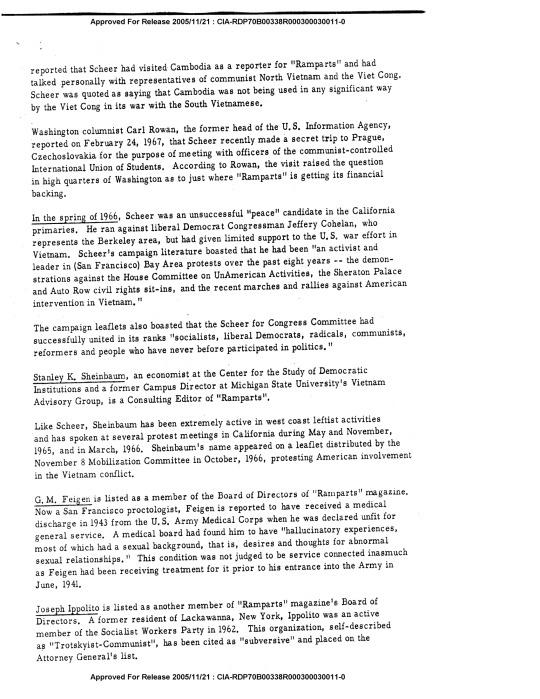
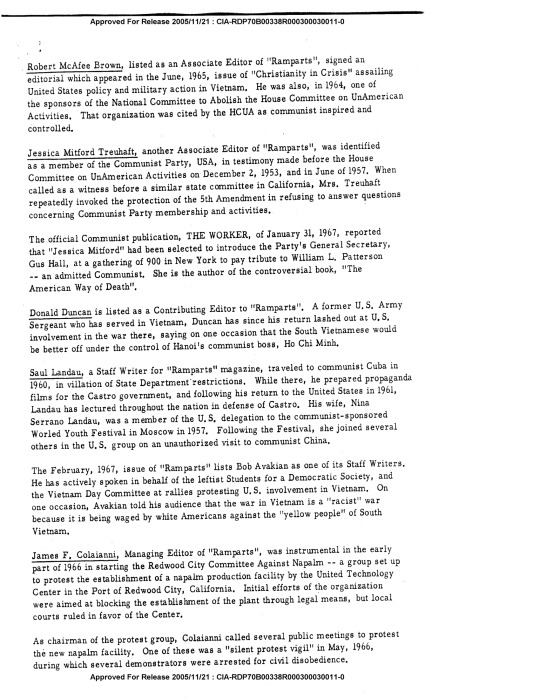

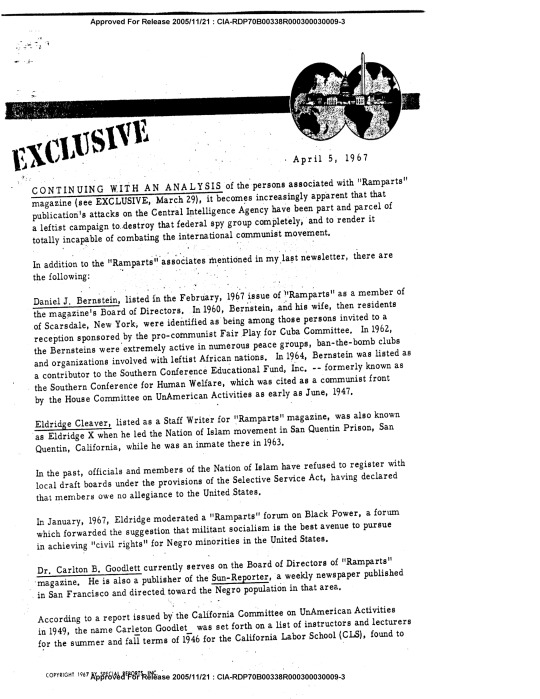

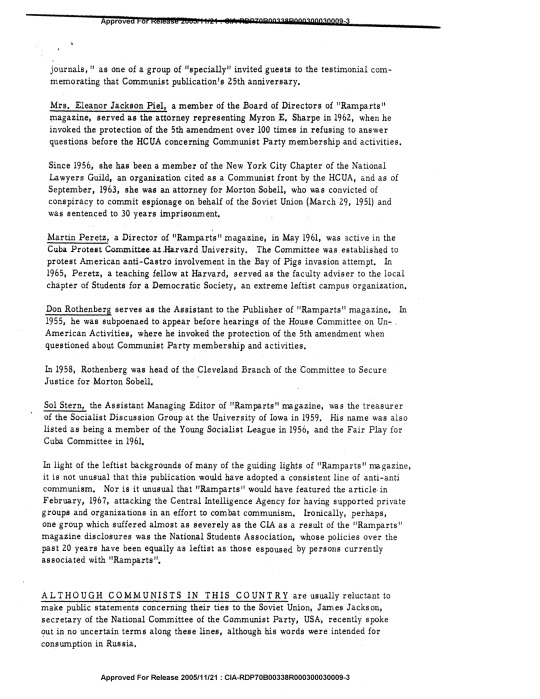
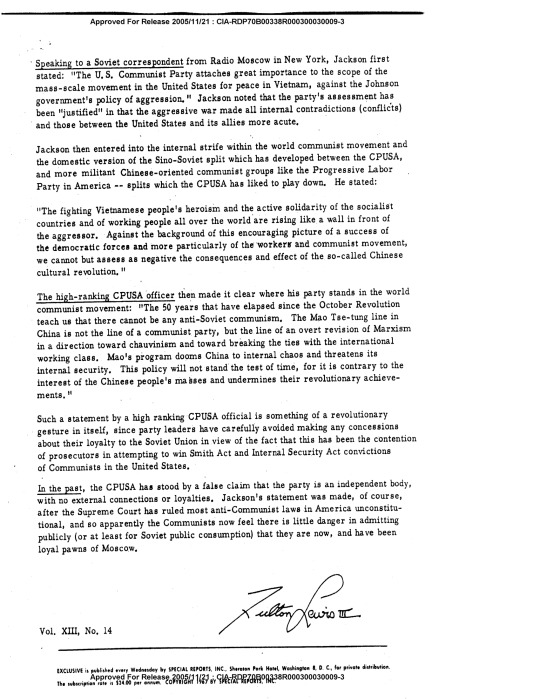
This series is shaping up to be about covert attempts by institutional power structures to undermine the health and safety of the international working class. The previous part, Part 4, is here. You can find a cool easter egg by seeing who the magazine in the bottom right image was delivered to.
The above is a dossier compiled by a right wing business intelligence group and purchased by the CIA not long after the events I’m about to share occurred. It is hosted on the CIA’s website for declassified files, the Reading Room. It was prepared by Fulton Lewis III, an outspoken supporter of the Rhodesian government and the son of a Hearst-sponsored anti-communist radio broadcaster, sort of the Tucker Carlson of the 40s and 50s. We don’t have the CIA’s own assessments because those are still classified.
When we last left the crew of the spaceship Ramparts, they were dealing with infiltration, incompetence, hedonism, an inability to secure funding, and the heady addiction of fame. Things were about to get worse as their own interpersonal disputes had come to the fore. Keating had seen his power at the magazine get whittled away as incentives in the form of shares for other backers became necessary. At the time, Hinckle counted among his friends Howard Gossage, an advertising whiz kid who helped popularize Marshall McLuhan and did the Sierra Club's first campaign. He frequently went to Gossage for advice. The two came up with a plan to push Keating into the 1966 Democratic primaries for the 11th district of California (later held by Leo Ryan, a CIA critic killed at Jonestown, and now held by Nancy Pelosi) as a way of reducing his influence on the day to day operations of Ramparts. In the midst of a meeting, they had two staff members slip away and come back with signs that said "Keating for Congress" and "Keating the people's choice".
By the start of 1966, however, the election bug had spread through the offices, both because it allowed Ramparts to make the news it reported on as salacious as possible, and because the Democratic Party had largely denied ballot access to anybody who was anti-Vietnam War. Bob Scheer, the foreign editor, ran in Oakland, and Stanley Sheinbaum, the Michigan State University professor who'd exposed the CIA's role on campus, ran in Santa Barbara. All gained 40-45% of the vote, mainly by cohering those opposed to the war. One thing in particular all three did was bring together the black vote (for instance, Julian Bond, mentioned previously in the series, campaigned for Scheer). Their campaigns were run by a coterie of Ramparts staffers, namely CPUSA member Carl Bloice as well as Berekeley lecturer Peter Collier, and were endorsed by a combination of black and Hollywood luminaries, for instance Dick Gregory, the civil rights activist and stand-up comedian, and Robert Vaughan, Napoleon Solo on the Man from Uncle and both a murderer and a victim on Columbo (see him argue about Vietnam on Firing Line with William Buckley here). Some of the opposition research on the three came directly from CIA files and was given to the establishment candidates by LBJ's press secretary Bill Moyers.
youtube
With the elections lost, Ramparts needed a new spin on things to bring back all the anti-electoral politics radicals. Fortunately, in nearby Oakland, a new group had just been founded called the Black Panther Party. Huey Newton and Bobby Seale like to portray their group as their own innovation, two upwardly mobile college kids shooting the shit late at night. The group they'd been part of prior to the BPP, the Maoist Revolutionary Action Movement, described them as "adventurists" for their desire to put theory to practice and finally organize in the community instead of just talking about it. Whatever the case, Newton learned from Robert Williams' Negroes with Guns that California law, influenced by white supremacist vigilanteism, allowed anyone to openly carry a weapon even in the presence of police. He went to Chinatown, bought copies of Mao's Little Red Book for cents, and sold them for dollars in Oakland as part of a course in organized self-defence, then used the money to buy shotguns and M-16s for use by graduates of the course. By February 1967, Ramparts staff writer Eldridge Cleaver had made contact at a speaking event for Malcolm X's widow Betty Shabazz, where the Black Panther Party founders and their cohort were the only ones armed. Cleaver invited them to the Ramparts offices for a sit down.
Remember the bit from the last part about Shabazz' bodyguards? That was Seale, Newton, and Co. Their arrival caused Hinckle's police buddies to get worried, and they put out an APB and surrounded the building, much to Newton's consternation. Hinckle suggested they go out for a drink, but nobody was buying it. Newton stared down a cop, who undid his holster. Seale put his hand on Newton, who told him off. "Don't hold my hand, brother." Seale released it, because that was his shooting hand. Newton taunted the officer. "You got an itchy trigger finger?... OK, you big, fat, racist pig, draw your gun!" All the Ramparts' staffers who'd come to watch as well as the officers' backup got the hell out of Dodge. Eventually, even the officer backed down. It was the first time the BPP had ever gotten the police to back down. It brought admiration from the entire Ramparts staff, who soon made the magazine the semi-official outlet of the BPP. And it brought Cleaver into their fold. They appointed him spokesman/Minister of Information within weeks. The following is the only news footage from that day shot after the incident, the rest having been lost, with Scheer in the background at one point:
youtube
And that wasn't even the most shocking thing going on at Ramparts. This series has previously mentioned the National Student Association as a bunch of debate nerds who essentially trained to have public speaking and organizing on their resume for future employers. The thing about the NSA was, it was a CIA front, and generally suspected as such. In 1947, there was an implosion of student politics' international facing groups. Those who had seen the Soviets fight in the Second World War generally accepted their claims to want world peace on their face, while the groups aligned with the Catholic Church teamed up with disparate right wing WASPs and Jews to fight back. The CIA had taken these students (to note, these were largely men in their late 20s or early 30s, grad rather than undergrad) under their wing and organized them into a front group that could report back on invitational events held in Eastern Europe. In turn, the top echelons of the NSA had to be sworn into legal secrecy as a prerequisite of participation, with the reward being entry into the old boys network of politicians and bureaucrats which virtually guaranteed a job.
The CIA fucked up. In 1965, the elected president of the NSA was Philip Sherburne. He was sworn into secrecy on the source of funding for their new HQ and general operations, as was normal for the group. But he disliked that they had only one source of funding, and he wanted the NSA to be independent. At the time, the grassroots in the organization who followed international politics and hewed to the left had managed to get some of their membership into power, but they had felt straitjacketed by the CIA's complete control of NSA finances. Many wanted to join in on the anti-war marches. Sherburne and others, spurred on by abrogation of Juan Bosch's regime in the Dominican Republic and the electoral fraud that brought the American-backed opposition to power, worked to find alternative sources of funding. They sent one an NSA man as part of the operation, but he got cold feet and worked with Sherburne to expose it. In response, the CIA had a number of top NSA men declared eligible for the draft in Vietnam. Bureaucratic fights ensued, involving the lives of students in America, Spain, Vietnam, and elsewhere. Finally, Sherburne went above the CIA's head to vice president Hubert Humprhey. In response, the CIA went and cut all of Sherburne's independent lines of funding. Unbenkownst to them, Sherburne had made a relatively radical student named Michael Wood his outside line to donors. He'd told Wood not to approach certain groups because they were backed by "certain government agencies". Wood had surmised that this meant the CIA and gone and picked up the only book out on the Agency: The Invisible Government, by David Wise and Thomas Ross. When he saw that the NSA's funding for 1966 had the same donor groups backed by the CIA, he realized Sherburne had lost and stole the files.
Twice the New York Times had published articles critical of the CIA in some form. In 1965, Texas congressman Wright Patman, initially elected on his support of the Bonus Army and ever a thorn in the establishment's side, had investigated 8 charitable foundations and found them to be CIA cutouts. The NYT had written an article on this as well as replies from the funded orgs (Encounter Magazine and the Congress for Cultural Freedom). In 1966, spurred by Ramparts' articles on MSU, NYT reporter Tom Wicker wrote of the allegations and added details of other botched operations around the world he'd heard from sources over the years. This brought the ire of the agency. In 1961, in response to details of the Bay of Pigs invasion being published in The Nation before it occurred, President Kennedy told his aides to bother him when details showed up in the New York Times because it otherwise did not matter. The CIA had actually worked hard to kill the very same story before the NYT could publish it so by the time the invasion failed, Kennedy apparently exclaimed that he wished more details had been published in the NYT so that the invasion would have been stopped. CIA agent Cord Meyer made the postscript of Part 3 of this series as the handler of much of the CIA's work through cutouts and allied groups like AFL-CIO, especially in in regards to the effort to influence the media known as Operation Mockingbird. Meyer and his wife, Mary Pinchot, were next door neighbours to the Kennedy's before JFK became president. Pinchot divorced Meyer after their child was killed in a car accident in 1957. She moved in with her brother-in-law, Ben Bradlee, later of Pentagon Papers and Watergate fame and played by Tom Hanks in the Steven Spielberg film The Post. In 1961, James Jesus Angleton, head of counterintelligence at the CIA, tapped her phone and discovered she was in a sexual relationship with JFK, including visits at the White House. When Pinchot was murdered in October 1964 in what was termed a robbery (a black man was arrested but acquitted), a friend of the family heard (he said) about the murder on the radio and phoned Bradlee first and Meyer second. Bradlee went to go find her diary and found Angleton sitting in her house (his garage) reading it. They later destroyed it. After that, Meyer became an alcoholic and compiled an enemies list of the CIA that included the Vice President. He was already fearful of a leak and told his subordinates to go after NSA staff but did not determine who Sherburne had told until his wiretaps of Ramparts phone lines informed him.
Ramparts, of course, knew that they had been tapped and kept phone calls brief. Scheer phoned Judith Coburn of the Village Voice and asked for her discretion. Wanting to break into a field dominated by men, Coburn felt like she was being called by a rock star, but nonetheless found it absurd that Scheer believed his calls to be tapped. She knew the CIA to be involved in assassinations like Lumumba's and thought their dealings with a minor org like the NSA were absurd. Ultimately, she helped by confronting a number of figures on their work. Eventually, a young WASP Harvard undergraduate who was on retainer from Ramparts named Michael Ansara got the call. His blog about it is excellent reading, located here. I quote:
One evening in the cold months of early 1967, my phone rang. A strange voice, obviously from New York asked, “Is this Michael Ansara?”
“Yes.”
“This is Sol Stern from Ramparts. Bob Scheer says you are our man in Boston.”
“Well . . . OK.”
“Listen I need you to do some work for us right away. I cannot tell you what it is about. I am calling you from a phone booth. Will you do it?”
“Well, what kind of work and are you willing to pay me for it?”
“It is research into two Boston based foundations. We will pay you $500.” 500 dollars was a lot of money. I had no idea how to research foundations, but I thought, what the hell. I could really use the money.
“Sure. What exactly do you want me to do?”
“I can’t tell you anything more than to find everything you can on the Sidney & Esther Rabb Foundation and Independence Foundation. They are based in Boston. I will call you in several days. You cannot call me. You cannot tell anyone what you are doing. You cannot mention the name Ramparts. Can I count on you?”
“I guess so. Sure. Yes.”
Ansara knew a much older man, an economist and lawyer who had sway in the Democratic Party named George Sommaripa. Sommaripa suggested Ansara go to a guy he knew at the IRS. Ansara did, and was told that under no circumstances could he have access to the files on two CIA cutout foundations. Chastened, Ansara complained to Sommaripa, who'd gotten the IRS clerk his job. A few days later, Ansara went back. The IRS clerk told him he could have any box he wanted, provided he did not go past the 990 form on the cover. He went past for the first two foundations and found that money came from an anonymous donor and in equal amounts went right out to the NSA. Ultimately, he pulled the files for 110 foundations, every single known group that the CIA used. He would look at the incorporation files for the foundations, see a lawyers' name, and look him up. Every time, the lawyer was an OSS operative during WW2, the predecessor org of the CIA. One of the lawyers had founded a firm with Sommaripa, a man named David Bird. Ansara confronted Bird, and Bird did not even stop to hang up on Ansara before phoning a contact at the CIA.
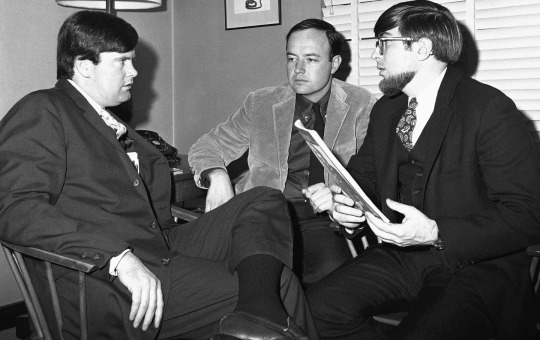
Left to right: Hinckle, Stern, Scheer.
A major corroboration of the story came from three students in New York who were disgusted by American foreign policy in Latin America. One in particular, Fred Goff, had been sent to the Dominican Republic with Allard Lowenstein (part 3) to observe the election of the pro-American candidate over the anti-American one. Goff had discovered that a man that Lowenstein had said he trusted on the country was actually a CIA agent, Sacha Volman. Another, Michael Locker, had done a paper about the CIA based on the NYT articles. Together, they walked in the doors of the AFL-CIO's American Institute for Free Labor Development and asked directly about the CIA, prompting a crashing sound and the institute's director, Thomas Kahn, planner of the 1963 March on Washington and the long-term romantic partner of Bayard Rustin, to scream at them.
The problem was when it came time to do the story. Sometimes, the researchers were paid by Ramparts. Other times, they received cheques from the Interchurch Center, a strange agency that serves as a front for charitable giving from the Episcopal, Lutheran, Presbyterian, Reformed, Methodist, and United Churches in America. James Forman, mentioned in previous parts, once led a picket in favour of reparations from them. Ramparts staff demanded they talk to them by picking up pay phones that would ring at designated times, a dismal failure. Other times, Hinckle, Scheer, and Sol Stern would fly in, book rooms at the Algonquin, and order massive amounts of takeout and booze. 15 to 20 people would be in a hotel room trying to negotiate who would be writing the story by continent, or by year, or by foundation. At one point, Coburn broke into the NSA HQ and unwittingly stole the original deed to their land, where it remained undiscovered in Ramparts' files till the 2010s.
On New Year's Eve, 1966, Lowenstein was hanging out with the new members of the NSA leadership when he informed them that Ramparts was writing about their relationship with the CIA. "The usual sloppy Ramparts piece, lots of flash, little substance," he said. The CIA had known since at least Thanksgiving. A lower level NSA official who'd just been sworn in went to meet with Hinckle and Scheer. The duo, while nonchalantly throwing darts, offered the Ramparts donor list as an incentive to tell all, but he refused. Sherburne attempted to find counsel in a lawyer who'd once opposed the CIA's new Langley HQ on NIMBY grounds. Meyer had threatened the lawyer's brother, working in Bogota with USAID, but the lawyer persisted. Undaunted, Meyer got word to Douglass Cater, the first president of the NSA and now an advisor to LBJ. LBJ bumped it to Lowenstein and the CIA to develop a response, which was to hold a press conference with an article in Henry Luce's (the man, not the monkey) Time Magazine that this was all well known since the 1965 congressional hearings, that the money was not that impressive, that the Soviets had done much more, etc.
This could have killed Ramparts. The IRS was already looking for any sign of foreign influence as an excuse to shut down the magazine. It needed some sort of relationship with the establishment press in a way that would let it gain influence without keeping it from the areas it wanted to report on. At the very same time, both Time and the NYT were reporting on the survival of Ramparts: Keating had attempted a coup and lost a board vote 13-1, with Mitford and other backers providing anonymous quotes that while they disliked the "Animal Farm-ish" nature of the issue, they needed Ramparts to stave off a fascist dictatorship in America. Hinckle followed by setting up an astounding agreement with the New York Times and Washington Post: they would get full access to Ramparts' files on the CIA right now, before the White House could set up a press conference, in exchange for letting them run full page ads for days for their next issue.
The day the Times went to press, February 13, 1963, was termed by former CIA director Richard Helms in his memoirs as "one of my darkest days". The press pushed, smelling blood. President Johnson ordered a suspension and review of CIA funding for outside orgs. The CIA initially tried to find a way to blame a dead president, Truman, but realized that its own documentation on the program, written by Cord Meyer, claimed that then-director Allen Dulles did not have any responsibility to inform the president of what he had ordered. Switching tactics, they turned on their press weapon, known as the Mighty Wurlitzer, and claimed that the CIA would have been remiss to not conduct these operations. "I'm glad the CIA is immoral" was the headline of an article by Meyer's boss, Thomas Braden. He described $250 million a year the CIA believed to be spent by the Soviet Union on cultural subversion, to which a mere handful of dollars from the CIA could not compare. No evidence for the accusations was provided, of course. Finally, Helms pulled in a favour from Robert Kennedy and had him testify to the press that his brother had authorized the funding, carried over from the days of Eisenhower. 12 former NSA presidents (including Lowenstein) came out and said the relationship was above board. All had worked for the CIA at least once after they'd left the NSA, but that was not revealed in their letter.
The strategy was a half-success. All the foundations funded by the CIA fell apart and students around the world became suspicious of CIA infiltration. Much of what Ramparts found was investigated by Congress repeatedly over the next decade, culminating in the reforms that came out of the Church Committee, which Helms claimed in his memoirs was sparked by Ramparts and Watergate. Certainly press readership was high, and many stories were published in the NYT and WaPo confirming and furthering the work done. At the same time, the CIA escaped with only a few new rules on its behaviour. President Johnson was a paranoic and was more concerned about using the CIA as a tool against his domestic enemies. He authorized a much larger role for MHCHAOS in punishing his enemies (remember the cryptonyms? MH was the most illegal, as it meant the USA). Many of those fingered were considered liberals in good standing and were part of the labour movement, particularly AFL-CIO higher-ups. They fell in line with the rhetoric about communist subversion because they knew they'd be the ones punished if things went further.
Interestingly, a few months later, the NSA held a vote on integrating an anti-Vietnam War and anti-draft stance into its platform. Traditionally, the CIA had worked from the shadows to suppress these votes. This time, Allard Lowenstein whipped in favour of the anti- stance and it won. Lowenstein soon became a fixture in the anti-LBJ movement, leading the call to bring Eugene McCarthy and Robert Kennedy into the Democratic presidential primaries. To a large extent, the organizations that were closed to the CIA had been products of decades-old relationships and worked in ways that nobody had bothered to improve. Within the CIA, a tension had always existed between bureaucrats with their own fiefdoms and up and comers with new ways of doing things. To a large extent, this scandal simply pushed the former out and made room for the latter, who would not do things like create financial records with the exact same dollar amounts going in and out, or act so bluntly when it came to manipulating staff. While the CIA may have suffered a little in the short term, it was an act of "creative destruction" that improved how the CIA did business. For Ramparts, on the other hand, things were going to get much worse now that they had drawn the ire of the intelligence community. While the magazine reached its peak distribution of 250,000 copies a month, it still did not bring in enough money to cover its expenses, and it was about to be faced with a much larger funding crisis: the Six Day War.
AFTER ALLEN DULLES RETIRED, the director bragged about the NSA operation. “We got everything we wanted. I think what we did was worth every penny. If we turned back the communists and made them milder and easier to live with, it was because we stopped them in certain areas, and the student area was one of them.”... Edward Garvey, who also worked at CIA headquarters, puts it more dramatically: “My God, did we finger people for the Shah?”... Stephen Robbins, despite his limited CIA involvement during his year as president, echoes Garvey’s concern: “It’s South Africa that keeps me up at night.”
#i am finding that i am including way too much information yet the details haunt me enough to make me put it in#i guess ramparts gets yet another part
27 notes
·
View notes
Text
Project: Windchill - WIP Intro

This is the adventure of one young man - Jeremy Elden, a young, previously-normal college student - to bring down the systems that oppress the community he didn’t know he belonged to. In fact, he didn’t even realize it existed.
In the face of adversity and oppression from the powers that be, Jeremy must learn to harness the new power inside him as he grows to accept that the people he was meant to trust hid pertinent information about the world. Now, he has to relearn everything he thought he knew with his mentors and friends - both new and old.
Can he live up to being their chosen one? Or will he fall short in the sea of powers that are so much stronger than him?
Everybody knows there’s 12 months in a year. But what if there were more? What if humans, just like other mammals in the world, hibernated during the coldest, cruelest months of the year? What if that wasn’t a biological response? What if humans were forced into this slumber, losing three months of their lives to an uncontested war?

Details:
Genre: Adult speculative fiction novel
Setting: Midland, Michigan
Themes: fighting against oppression, freedom of expression, self-discovery
Content Warnings: character death, explicit and graphic depictions of violence
Features: LGBTQ+ protagonist and supporting characters, multiracial cast
Status: Draft 1 (Act 1/3)
Projected Release Date: TBD
The Rebellion
~ The Protagonist ~

Jeremy Elden (21) - a spirited college student. His new kid status hasn’t gotten him many friends in the rebellion, but his place in the prophecy definitely does. But is he really “the chosen one” like these people say? Or is he just cannon fodder for their fight against their oppressors?
~ The Supporting Cast ~

(art by @jasperygrace on Tumblr) Quincy Jackson (25) - a human lie detector. He first met Jeremy in the creative writing club on their college campus two years prior. They didn’t really speak until the next year, when they started hanging out regularly to write outside of school. But when Quincy appears on Jeremy’s doorstep, Jeremy has to rethink everything he knew about his friend.

Terrence Jackson (25) - the brute force powerhouse of the Rebellion. Terry is Quincy’s twin brother, the “body” to Quincy’s “soul.” The two are inseparable, but how will their tight bond hold up in the war they find themselves thrown into every year?

David Marino (22) - a young man with a strange fascination - Jeremy. What started as hero worship slowly fades once he realizes that Jeremy is an absolute disaster with no idea how to save the world. David is determined to help Jeremy on his journey to save the mutants of the world before they are eradicated by the powers that be. How is he supposed to do that when he has no plan?

Frost (???) - a young woman with a mysterious past. Her jovial, friendly nature disarms the adults of the Rebellion, but she quickly turns as cold as her powers when pushed too far about her past. She gets along with everyone, but will she get along with Jeremy when he becomes the new symbol of the Rebellion?

Elliot Lachman (48) - Jeremy’s very tired mentor. He is the right hand of the Rebellion’s leader, Julia, and takes charge in Jeremy’s training to become the savior of the world’s mutant population. His knowledge of the world has gotten him to where he needs to be, but how long will it be until that knowledge runs out?
The Extermination Task Force

Beelzebub (20) - the leader of the mutant extermination task force, a covert operations team under the federal government’s control. Bael was taken in by the government’s covert ops team at a young age and given his new name, hiding his old self deep in the recesses of his mind. Is he meant to stay under the government’s hold for the rest of his life? Or will he find freedom in unlikely places?

Samael (19) - the right hand to Bael in the task force. He was born with only two eyes, but his handlers determined that “biblically accurate angel” fit him better. He is always hesitant to cause destruction in the world despite the angel he was named after being the Angel of Death. How long can he last in the government’s control? Will he cave under the pressure?
Navigation
WIP Page: TBA
Main Tag: #project: windchill
Project Updates: #pro:wind updates
About the Author
C. E. Thomas is a writer and artist with an interest in mythology and conspiracy theories. While they do not believe in these stories, they like to incorporate them into their works. They are currently pursuing a degree in Biological Sciences and hope to work in the pathology field.
8 notes
·
View notes
Text
Michigan Elanter Elants shows the challenge safely to restart old reactors
Palisades nuclear power plant in Covert, Michigan, February 24, 2025. Spencer Kimball CNBC Catlet, Mich. – The nuclear power plant on the shores of Lake Michigan intends to create the history of this fall, becoming the first reactor in the USA, which re -launted operations after closing to be finally dismantled. Efforts to restart Palisades near South Haven, which closed three years ago, is a…
0 notes
Text
Michigan Elanter Elants shows the challenge safely to restart old reactors
Palisades nuclear power plant in Covert, Michigan, February 24, 2025. Spencer Kimball CNBC Catlet, Mich. – The nuclear power plant on the shores of Lake Michigan intends to create the history of this fall, becoming the first reactor in the USA, which re -launted operations after closing to be finally dismantled. Efforts to restart Palisades near South Haven, which closed three years ago, is a…
0 notes
Link
0 notes
Text
#america first#president donald trump#j.d. vance#elon musk#steve bannon#speaker johnson#u.s. house of representatives#red state news#michigan news#minnesota news#missouri news#wisconsin news#indiana news#illinois news#iowa news#ohio news#pennsylvania news#virginia news#north carolina news#georgia news#florida news#arizona news#nevada news#new york news#new jersey news#new hampshire news#maine news#texas news#colorado news#california news
0 notes
Text
COVERT TWP. — The owner of Palisades Nuclear Plant, Holtec International, took a step forward Tuesday in efforts to reopen the shuttered plant.
Holtec jointly announced with Wolverine Power Cooperative a long-term power purchasing agreement they say will pave the way for the plant to restart.
It's true a purchase agreement was an important step in the plant's reopening checklist, but it’s not the final piece of the puzzle. Holtec Director of Government Affairs and Communications Patrick O’Brien confirmed to The Sentinel that Holtec is still waiting on a decision on its loan request from the Department of Energy and full approval from the Nuclear Regulatory Commission.
“We’re still in the process with (the DoE)," he said. "We’re hoping to hear by the end of the year, one way or the other. We still feel like that’s a good timeline.”
The agreement announced Tuesday, Sept. 12, states Wolverine will purchase up to two-thirds of the power generated by Palisades for its Michigan-based rural electric cooperatives. The company's project partner, Hoosier Energy, will purchase the rest.
“We are thrilled to enter into this partnership,” Kelly Trice, president of Holtec Nuclear Generation and Decommissioning, wrote in a press release. “The executed power purchase agreement represents a significant milestone in our journey towards reopening the plant, a historic moment for Michigan and the country.
“The repowering of Palisades ensures Michigan has sufficient energy to meet future demand and mitigate the impact of climate change, while creating hundreds of high-paying Michigan jobs, expanding the local tax base, and unleashing economic opportunity within the region and beyond."
Officials say reopening Palisades will “greatly enhance electric reliability” by generating “consistent and carbon-free energy” in the state.
“Ensuring reliable and affordable electricity in Michigan is crucial,” said Eric Baker, CEO of Wolverine. “The restart of Palisades offers a practical, long-term solution to electric reliability in our state and aligns with Michigan's ambitious goals to reduce carbon emissions.”
Palisades shuttered in May 2022 after 50 years in operation. The 800-megawatt plant employed around 600 people full-time. A recently published study estimated the closure had an economic impact of over $250 million in Berrien, Cass and Van Buren counties.
Just months after it closed, an effort to reopen the plant was announced. Holtec's first loan application failed, but the second, ongoing attempt was launched in early 2023.
Holtec has already secured a $150 million investment from the state. In addition to obtaining the DoE loan and getting approval from the NRC, Holtec will need to rehire and retrain staff. Officials have estimated it will take about two years to get Palisades operational again, if and when the process begins.
2 notes
·
View notes
Text

During the decades of segregation in the United States, African Americans established various resorts. The resorts were self-contained commercial establishments. Varying resort accommodations included rooms for rent, meals and fine food, cocktail bars, dancing, sporting facilities (such as golf, horseback riding, tennis, swimming pools, fishing, badminton), and beaches. Entire communities (or towns) became resort areas for African Americans. The Negro Motorist Green Book helped guide African Americans to accommodating and safe places, including Idlewild, Michigan, which was among the most well known.
California
Bay Street Beach (also known as "the Inkwell") in Santa Monica, California
Bruce's Beach in Manhattan Beach, California
Eureka Villa (now Val Verde) in California
Lake Shore Beach Club on Lake Elsinore in Riverside County, California
Murray's Dude Ranch in Apple Valley, California
Pacific Beach Club in Orange County, California
Peck's Pier and Pavilion in Manhattan Beach, California
Colorado
Lincoln Hills Country Club in Gilpin County, Colorado
Florida
American Beach, Florida
Bethune Beach, Florida
Bruce Beach in Pensacola, Florida
Butler Beach in St. Johns County, Florida
Hampton House in Miami, Florida
Manhattan Beach (now Hanna Park) in Jacksonville, Florida
Paradise Park, Florida
Virginia Key Beach in Virginia Key, Florida
Indiana
Fox Lake in Angola, Indiana
Maine
Jewell Inn in York Beach, Maine
Maryland
Arundel on the Bay, Maryland
Carr's Beach in Anne Arundel County, Maryland
Highland Beach, Maryland
Sparrow's Beach, south of Annapolis, Maryland
Massachusetts
Camp Twin in Kingston, Massachusetts
Jones' Cottage in Hyannis, Massachusetts
Kingston Inn in Kingston, Massachusetts
Oak Bluffs in Martha's Vineyard, Massachusetts (also referred to as The Inkwell)
Dunmere-by-the-sea in Oak Bluffs, Massachusetts
Shearer Cottage in Oak Bluffs, Massachusetts
The Roost in Osterville, Massachusetts
The Wigwam in Mashpee, Massachusetts[citation needed]
Michigan
Blue-Bird Motel in Covert, Michigan
Brooks Castle Farm in Grand Junction, Michigan
Glover's Chi-Acres in Paw Paw, Michigan
Idlewild, Michigan
Dulin's Motel in Idlewild, Michigan
Lydia Inn in Idlewild, Michigan
Pitchford's La Maison in Covert, Michigan
The Linwood Hotel in Detroit, Michigan
Mississippi
Gulfside Assembly in Waveland, Mississippi
New Jersey
Beach 3 in Long Branch, New Jersey
Missouri Avenue Beach in Atlantic City
Chicken Bone Beach in Atlantic City, New Jersey
Liberty Hotel in Atlantic City, New Jersey
Park Plaza Motel in Atlantic City, New Jersey
Efra Court Motel in Wildwood, New Jersey
Harmon Motel in Wildwood, New Jersey
Rose Marie Manor in Wildwood, New Jersey
New York (state)
Coleman's Lodge in Bloomingburg, New York
Eastville in Sag Harbor, New York
Greenwood Forest Farms (also known as "The Colony") near Greenwood Lake in New York
Kings Lodge in Otisville, New York
Maple Valley Farm in Pine Bush, New York
Morgan Hill Lodge in Kingston, New York
Paradise Farm in Cuddebackville, New York
Peg Leg Bates Resort in Kerhonkson, New York
Rainbow Acres in Kerhonkson, New York
Sag Harbor Hills, Azurest, and Ninevah Beach Subdivisions Historic District in Sag Harbor, New York
Smith Haven in Pine Bush, New York
Utopia Lodge in Greenfield Park, New York
North Carolina
Freeman Beach (now Freeman Park) in North Carolina
Shell Island, North Carolina
Pennsylvania
Hillside Inn in East Stroudsburg, Pennsylvania
South Carolina
Atlantic Beach, South Carolina in South Carolina
Mosquito Beach, now part of Mosquito Beach Historic District, in South Carolina
Virginia
Bay Shore Beach (now Buckroe and Fort Monroe) in Virginia
Mark Haven Beach Hotel in Tappahannock, Virginia
Buckroe Beach near Hampton, Virginia
Washington, D.C.
Hains Point with Langston Golf Course in East Potomac Park
West Virginia
Hill Top House Hotel in Harpers Ferry, West Virginia
Wisconsin
Al's Silver Ridge Resort in Webster, Wisconsin
Goplana in Wisconsin Dells, Wisconsin
Lazy M Ranch in Wisconsin Dells, Wisconsin
Lake Ivanhoe, Wisconsin
See also
[edit]
Black-owned businesses
Chitlin' Circuit
Index of articles related to African Americans
List of African-American neighborhoods
List of African American hotels, motels, and boarding houses
Racial segregation in the United States
Reservation of Separate Amenities Act, 1953 in South Africa
0 notes
Text
Thursday, February 20, 2025
Trump administration fires thousands for ‘performance’ without evidence (Washington Post) The first message from her manager on Saturday afternoon misspelled Amanda Mae Downey’s name. The second mentioned “the news” about probationary federal workers and how the Trump administration planned to fire them. When Downey called her boss at a Michigan branch of the U.S. Forest Service for an explanation, she learned her name was on a firing list. She would have to come into the office to sign a letter formalizing her termination. And she had to do it before the holiday weekend was over. Many federal government employees were dismissed over the holiday weekend as managers confronted a Trump administration demand to fire workers by Tuesday. In group texts and in online forums, they dubbed the error-ridden run of firings the “St. Valentine’s Day Massacre.” The firings targeted new hires on probation, who have fewer protections than permanent employees, and swept up people with years of service who had recently transferred between agencies, as well as military veterans and people with disabilities employed through a program that sped their hiring but put them on two years’ probation. The Trump administration will not disclose how many workers it cut since last week, but the government employed more than 200,000 probationary workers as of last year. The termination letters hitting inboxes all struck the same note: Probationary workers were getting the ax for poor job performance. But many of those fired had just received positive reviews, or had not worked in the government long enough to receive even a single rating.
Trump says AP will be curtailed at the White House until it changes its style to Gulf of America (AP) President Donald Trump said Tuesday that he will continue to restrict The Associated Press’ access to his events and news conferences until the news outlet goes along with his renaming of the Gulf of Mexico in its reports. He acknowledged that the move was a presidential retaliation against the news agency’s editorial policy. “We’re going to keep them out until such time as they agree that it’s the Gulf of America,” Trump said, speaking to reporters who witnessed the signing of an executive order at Mar-a-Lago, his Florida estate. “We’re very proud of this country, and we want it to be the Gulf of America.” It was the first time the president himself had commented on the issue since the White House began not allowing AP to cover several of his events last week.AP spokeswoman Lauren Easton said Tuesday that “this is about the government telling the public and press what words to use and retaliating if they do not follow government orders. The White House has restricted AP’s coverage of presidential events because of how we refer to a location.”
Winter’s next wave of storms takes aim at the East Coast (AP) The latest in a long line of winter storms is taking direct aim at the East Coast, threatening to dump heavy snow and some ice in several states. A storm that dropped snow in the Midwest was spreading across the Tennessee and Ohio Valleys on Wednesday, bringing more misery to some places just starting to clean up from deadly weekend floods. Up to 10 inches (25 centimeters) of snow was possible along the Atlantic Coast in Virginia and significant ice accumulations were forecast in eastern North Carolina, the National Weather Service said. Elsewhere, a polar vortex took over from Montana to southern Texas. Bismarck, North Dakota, hit minus 39 degrees (minus 39.4 C) early Tuesday, breaking a record for the date set in 1910.
C.I.A. Expands Secret Drone Flights Over Mexico (NYT) The United States has stepped up secret drone flights over Mexico to hunt for fentanyl labs, part of the Trump administration’s more aggressive campaign against drug cartels, according to U.S. officials. The covert drone program, which has not been previously disclosed, began under the Biden administration, according to U.S. officials and others familiar with the program. But President Trump and his C.I.A. director, John Ratcliffe, have repeatedly promised more intense action against Mexican drug cartels. Increasing the drone flights was a quick initial step. The C.I.A. has not been authorized to use the drones to take lethal action, the officials said, adding that they do not envision using the drones to conduct airstrikes. For now, C.I.A. officers in Mexico pass information collected by the drones to Mexican officials. The flights go “well into sovereign Mexico,” one U.S. official said. The drones have proved adept at identifying labs, according to people with knowledge of the program. Fentanyl labs emit chemicals that make them easy to find from the air.
Brazil Charges Bolsonaro With Plotting a Coup After 2022 Election Loss (NYT) Jair Bolsonaro, Brazil’s former president, was charged on Tuesday with overseeing a vast scheme to hold on to power after losing the 2022 election, including one plot to annul the vote, disband courts and empower the military, and another to assassinate the nation’s president-elect. The accusations, laid out in a 272-page indictment, suggest that Brazil came strikingly close to plunging back into, in effect, a military dictatorship nearly four decades into its modern democracy. Attorney General Paulo Gonet Branco indicted Mr. Bolsonaro and 33 other people, including a former spy chief, defense minister and national security adviser, accusing them of a series of crimes against Brazil’s democracy. The case will now go before Brazil’s Supreme Court, which will decide whether to order Mr. Bolsonaro’s arrest and have him face trial. If convicted, he could face 12 to 40 years in prison, according to the indictment, though political analysts expect any sentence to be shorter.
Farming in France is on the decline. Who will feed the French? (CSM) Jean-Baptiste Maillier kicks through hay and mud as he passes through the open archway into his barn. Inside, a row of hulking Normande cows is lined up head to tail at the milking machine. After a loud beep, one steps onto a metal plate as a set of white tubes descends onto her teats. Fresh milk pours into a plastic receptacle below her. Here in Houdan, this scene is increasingly rare. Ten years ago, there were 22 dairy farmers in the area. Now, Mr. Maillier is the only one. Half of all France’s farmers are expected to retire in the next five years, and few young people are signing up to take their place. At stake is not just the survival of French agriculture but also a key part of what it means to be French: its food culture. Now, the French must decide how far they are willing to go to keep their diverse terroirs alive, says Jean-Pierre Poulain, a professor emeritus of food culture at the University of Toulouse—Jean Jaurès. As food prices rise and cheap imports crowd local goods off the shelf, “Are they willing to spend more on French-made products instead of buying a new cellphone?” he wonders.
US, Russia forge ahead on peace talks, without Ukraine (Reuters/NYT) U.S. President Donald Trump’s administration said on Tuesday it had agreed to hold more talks with Russia on ending the war in Ukraine after an initial meeting that excluded Kyiv. As the 4-1/2-hour meeting in the Saudi capital was underway, Russia hardened its demands, notably insisting it would not tolerate the NATO alliance granting membership to Ukraine. Ukraine has said it will not accept any deal imposed without its consent, and German Chancellor Olaf Scholz reiterated “there must be no decision over the heads of Ukraine.” Even before the talks took place, some European politicians accused Trump’s administration of handing free concessions to Moscow last week by ruling out NATO membership for Ukraine and saying it was an illusion for Kyiv to believe it could win back the 20% of its territory now under Russian control. Although Europe wants a larger role in the peace talks, it’s also divided about the aftermath. Consider European leaders’ recent talks about deploying soldiers in Ukraine after the war: France supported the idea. Britain conditioned its deployment on American backup. Poland said it needed to keep its forces at home to defend its own borders from Russia. Germany said these discussions were premature. None of this inspires much confidence for Ukraine. The West has fractured, and Russia knows it.
Trump calls Zelensky a 'dictator' as he hits back at 'disinformation' criticism (BBC) Donald Trump has escalated a war of words with Ukrainian President Volodymyr Zelensky, branding him a “dictator” who has done a “terrible job”. “Zelensky better move fast or he is not going to have a country left,” the US president wrote in a post on his Truth Social platform. Trump was hitting back after Zelensky earlier accused him of “living in a disinformation space” created by Russia, following US-Moscow talks about ending the war in Ukraine—which Kyiv was excluded from. The barbed comments traded between the two leaders began on Tuesday when Trump claimed Zelensky has an approval rating of 4% and appeared to blame Ukraine for starting the war.
As Israel uses US-made AI models in war, concerns arise about tech’s role in who lives and who dies (AP) U.S. tech giants have quietly empowered Israel to track and kill many more alleged militants more quickly in Gaza and Lebanon through a sharp spike in artificial intelligence and computing services. But the number of civilians killed has also soared, fueling fears that these tools are contributing to the deaths of innocent people. Israel’s recent wars mark a leading instance in which commercial AI models made in the United States have been used in active warfare, despite concerns that they were not originally developed to help decide who lives and who dies. “This is the first confirmation we have gotten that commercial AI models are directly being used in warfare,” said Heidy Khlaaf, chief AI scientist at the AI Now Institute and former senior safety engineer at OpenAI. “The implications are enormous for the role of tech in enabling this type of unethical and unlawful warfare going forward.”
Palestinian families flee West Bank homes in droves (AP) By car and on foot, through muddy olive groves and snipers’ sight lines, tens of thousands of Palestinians in recent weeks have fled Israeli military operations across the northern West Bank—the largest displacement in the occupied territory since the 1967 Mideast war. After announcing a widespread crackdown against West Bank militants on Jan. 21—just two days after its ceasefire deal with Hamas in Gaza—Israeli forces descended on the restive city of Jenin, as they have dozens of times since Hamas’ Oct. 7, 2023, attack on Israel. But unlike past operations, Israeli forces then pushed deeper and more forcefully into several other nearby towns, including Tulkarem, Far’a and Nur Shams, scattering families and stirring bitter memories of the 1948 war over Israel’s creation. During that war, 700,000 Palestinians fled or were forced from their homes in what is now Israel. That Nakba, or “catastrophe,” as Palestinians call it, gave rise to the crowded West Bank towns now under assault and still known as refugee camps. “This is our nakba,” said Abed Sabagh, 53, who bundled his seven children into the car on Feb. 9 as sound bombs blared in Nur Shams camp, where he was born to parents who fled the 1948 war.
Medical evacuations from Gaza slow amid uncertainty over right of return (Washington Post) For many Palestinians with critical injuries or chronic illnesses, a medical evacuation out of the Gaza Strip is the only way to access lifesaving care. But now, after President Donald Trump proposed to empty Gaza of its inhabitants, aid workers and doctors say they fear that those leaving the territory could be forfeiting their ability to one day return home. Inside Gaza, the evacuations have slowed for a range of reasons, including this uncertainty and tightened security checks, according to doctors and aid workers. At the same time, fewer countries are accepting evacuees, a development that aid workers say could partially be a result of fatigue more than a year into the crisis but that also reflects the growing fear that those who leave will not be allowed to return. All of this means a longer wait for families with injured loved ones. But doctors who have worked in Gaza’s hospitals say many of the people awaiting medical evacuations don’t have time. The World Health Organization says 25,000 people in Gaza are in need of medical evacuation, including 2,500 children who need urgent attention for war wounds and for chronic diseases like cancer that cannot be treated in the territory.
Residents say Rwanda-backed rebels are advancing on a third city in eastern Congo (AP) Rwanda-backed rebels appeared to be heading toward a third major city in eastern Congo, residents said Tuesday, as international pressure rose over the M23’s expansion in a mineral-rich region that’s critical for global technology. The M23 rebels on Tuesday attacked all the main Congolese army positions on the road to Butembo, a city of 150,000 people, and the situation was rapidly deteriorating, said Auguste Kombi, a civil society leader in Kitsombiro, a town along the road. Butembo is about 210 kilometers (130 miles) north of Goma, the city of over 2 million people that the M23 rebels seized last month as about 3,000 people were killed.
2 notes
·
View notes